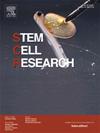爱德华兹综合征患者诱导多能干细胞BAFYi001-A的建立
IF 0.8
4区 医学
Q4 BIOTECHNOLOGY & APPLIED MICROBIOLOGY
引用次数: 0
摘要
爱德华兹综合征(18号三体)是一种遗传疾病,其特征是存在额外的18号染色体。一种特异性诱导多能干细胞(iPSC)系,命名为BAFYi001-A,使用无整合仙台病毒方法从爱德华兹综合征患者的脐带源性间充质间质细胞(UC-MSCs)中生成。该细胞系表达了在18三体背景下鉴定未分化hipsc、三期分化潜力和遗传保真度的标记。因此,该细胞系可作为研究爱德华综合征发病机制的可靠体外模型。本文章由计算机程序翻译,如有差异,请以英文原文为准。
Establishment of human induced pluripotent stem cell line BAFYi001-A from a patient with Edwards syndrome
Edwards’ syndrome (trisomy 18) is a genetic disorder characterized by the presence of an extra chromosome 18. A specific induced pluripotent stem cell (iPSC) line, named BAFYi001-A, was generated from the umbilical cord-derived mesenchymal stromal cells (UC-MSCs) of a patient with Edwards syndrome using an integration-free Sendai virus method. This line expresses markers for identifying undifferentiated hiPSCs, trilineage differentiation potential, and genetic fidelity in the context of trisomy 18. Therefore, this cell line serves as a reliable in vitro model for investigating the pathogenesis of Edward syndrome.
求助全文
通过发布文献求助,成功后即可免费获取论文全文。
去求助
来源期刊

Stem cell research
生物-生物工程与应用微生物
CiteScore
2.20
自引率
8.30%
发文量
338
审稿时长
55 days
期刊介绍:
Stem Cell Research is dedicated to publishing high-quality manuscripts focusing on the biology and applications of stem cell research. Submissions to Stem Cell Research, may cover all aspects of stem cells, including embryonic stem cells, tissue-specific stem cells, cancer stem cells, developmental studies, stem cell genomes, and translational research. Stem Cell Research publishes 6 issues a year.
 求助内容:
求助内容: 应助结果提醒方式:
应助结果提醒方式:


